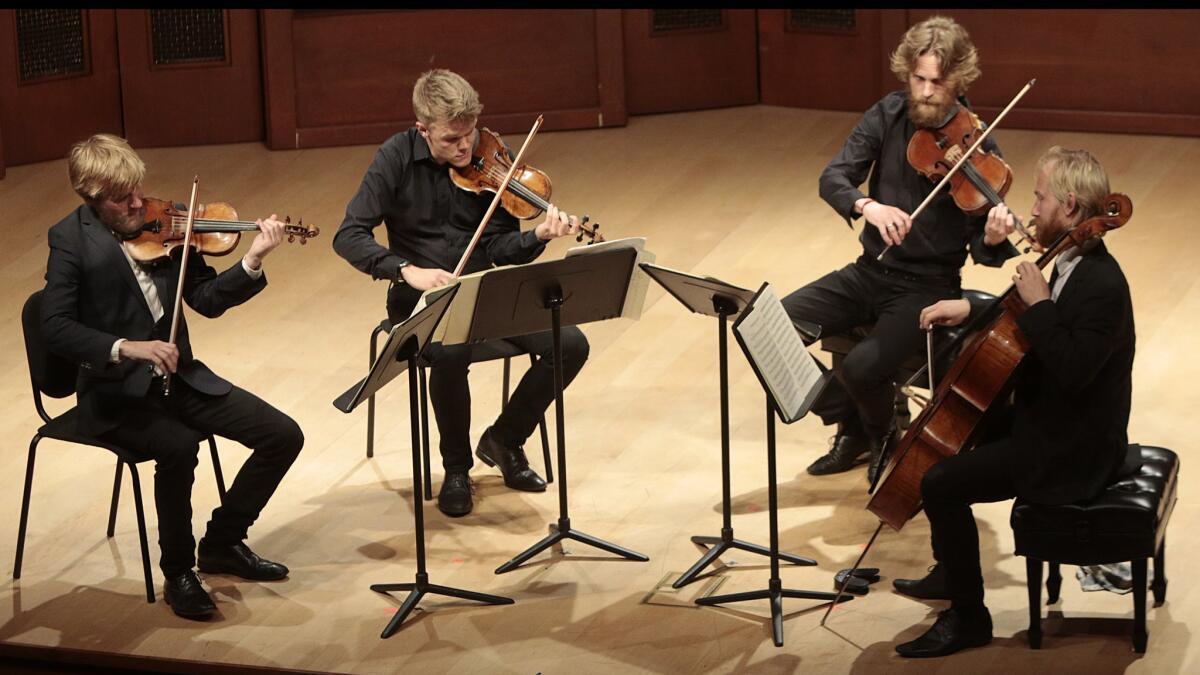Review: Danish String Quartet makes a truly fab four in Santa Barbara

Reporting from SANTA BARBARA — Danes are the most content of the world’s great discontents. Credited as home to the happiest people on Earth, Denmark — and Copenhagen in particular — is home to what has been called the world’s best restaurant, the most environmentally friendly urban bike lanes, some of the world’s best design and most beautiful people.
It has also given us the marvelous Danish String Quartet, which appeared in Hahn Hall at the Music Academy of the West on Tuesday night.
The secret to all that satisfaction is often credited to an inherent Danish fatalism, an acceptance of life as it is.
The Danish String Quartet embodies a great deal that is admirable about Scandinavia. It has a stunningly elegant rounded sound, four guys in their early 30s who play like one. They are also four hip guys who appear to be going through a little bit of an identity crisis. Like another Fab Four of old, every new recording or publicity shot reveals different degrees of facial hair and different hairstyles, along with increasingly informal dress.
The quartet’s repertory also is going through a bit of upheaval, adding modern angst and folk music repose to otherwise solid classical foundation. The group’s latest release, “Wood Works,” is bathed in an aura of backwoods Scandinavian fiddlers. In the recommended high-quality vinyl version, the LP jacket looks as if the record could be a Danish classical update of the Band.
In a rare Southern California appearance as part of UC Santa Barbara’s Arts & Lectures series, the ensemble felt Danish to the core. (The quartet will finally make its local debut in February in the Coleman series at Caltech.) It began with Haydn’s late String Quartet, Opus 77, No. 1, a work upbeat on the surface, but leave it to these Danes to show Haydn’s surprise harmonies and turns of phrase to be hidden dark corners in an otherwise aging composer-optimist. It ended with Beethoven’s most visionary late quartet, No. 14 in C-Sharp Minor, Opus 131. In this case, Opus 131 served as a corrective to the evening’s middle score.
In 2011, the Danish String Quartet and composer Thomas Agerfeldt Olesen were awarded the Carl Nielsen Prize, Denmark’s largest cultural prize, which is named after the country’s national composer. It seemed only natural for the players to ask Olesen to write a string quartet for them.
“Nielsen was a positive guy,” violist Asbjorn Norgaard explained to the audience. “Olesen is not a positive guy.” Nielsen’s most famous symphony is called “The Inextinguishable,” a work in which music is meant to show that, depressing as life is, there is a high moral need for struggle, and that music can lift the spirit to higher purpose.
Olesen has titled his Seventh Quartet “The Extinguishable.” It is a piece full of interruptions, just as the essence of life is a series of interruptions that lead to the final one. The quartet starts out with the cello stuck in a rut, bowing the same note over and over. The other instruments play fluty figures, as though a kind of string quartet birdsong might be a freeing agent.
A hauntingly tonal middle section is, as Norgaard described it, a memory of when you might once have had hope. It is inevitably full of stops and starts. The cello figure returns at the end of the piece, but the struggle is over, and it now sounds almost ethereal.
“Life isn’t going to go on forever,” Norgaard explained. “Since we don’t have any hope, maybe it’s a good thing that we don’t live forever.”
In this context, the group made Beethoven’s great C-Sharp Minor string quartet into “the unflappable.” Over a 40-minute span, Beethoven fights gravity, in both senses of the word. He is gravely serious and struggling with freeing himself from earthly struggle. The players were here both as Scandinavians riveted to the land and as artists questing for liberation.
Their command of the quartet’s challenging arch-shape formal structure was complete. They could be grounded in their tone or mystical. They allowed time to stand still, and they could assume the pose of excitingly aggressive rockers. They did it all.
Beethoven, however, was no fatalist but, rather, a spiritually transcendent discontent. As an evolving young string quartet, the Danish provides inevitably young Beethoven and inevitability. It is better thus far at providing answers than letting spiritual provocations remain mysterious. But there could be no arguing with great playing.
Twitter: @markswed
More to Read
The biggest entertainment stories
Get our big stories about Hollywood, film, television, music, arts, culture and more right in your inbox as soon as they publish.
You may occasionally receive promotional content from the Los Angeles Times.











